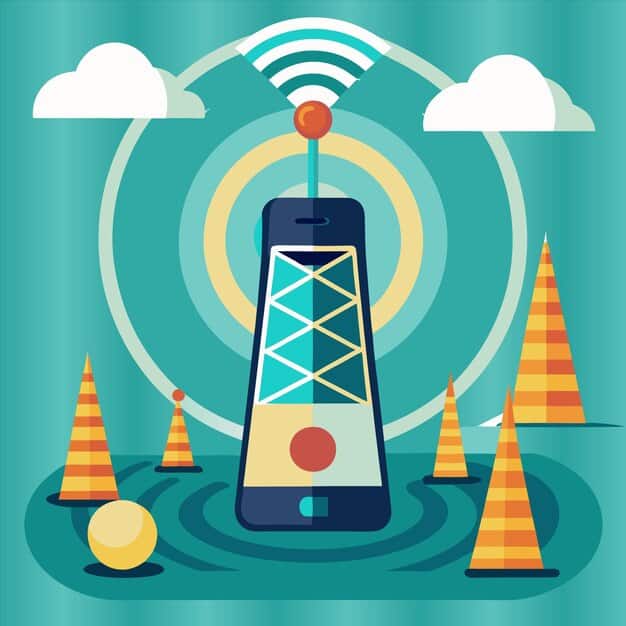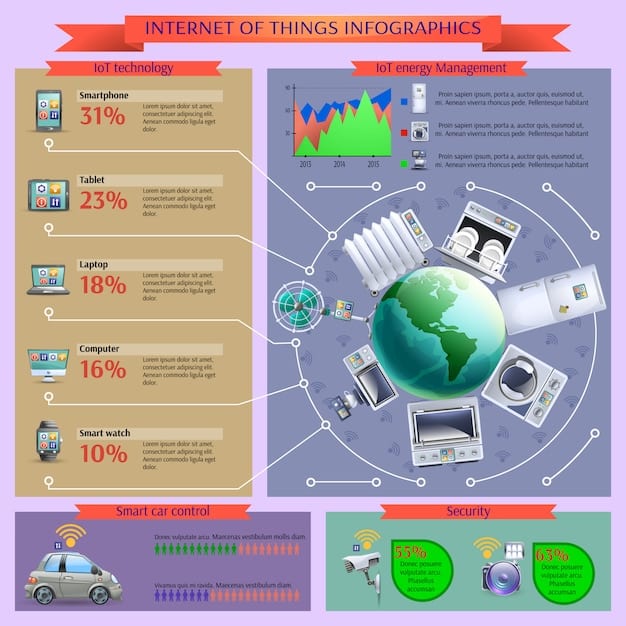Wireless Power Transfer: Charging Cables Gone by 2026 in US Homes?

Wireless power transfer technology aims to eliminate charging cables in US homes by 2026, offering convenience and aesthetic improvements, but faces challenges in efficiency, range, and safety regulations, suggesting a gradual rather than complete replacement.
Imagine a home without the clutter of charging cables. Wireless power transfer: Can it eliminate charging cables in US homes by 2026? This is the question many are asking as wireless charging technology continues to evolve. Let’s explore the possibilities and challenges of a cable-free future in the US.
The Promise of Wireless Power Transfer
Wireless power transfer (WPT) offers the enticing prospect of powering devices without the need for physical connectors. This technology promises to declutter homes, enhance convenience, and open new design possibilities for electronic devices. But how close are we to achieving this cable-free dream?
WPT isn’t a new concept; Nikola Tesla demonstrated it over a century ago. However, recent advancements in technology and increasing consumer demand for convenience have spurred renewed interest and investment in WPT solutions.
How Wireless Power Transfer Works
Wireless power transfer relies on several different methods to transmit energy through the air. Understanding these methods is key to assessing the potential and limitations of WPT.
- Inductive Charging: This is the most common form of wireless charging currently available. It uses two coils, one in the charger and one in the device, to transfer energy via an electromagnetic field when in close proximity. Think of it like a transformer with air between the coils.
- Resonant Charging: Similar to inductive charging but more efficient over longer distances. It uses resonant frequencies to maximize energy transfer between the transmitter and receiver coils.
- Radio Frequency (RF) Charging: This method converts electrical energy into radio waves, which can then be captured by a receiver and converted back into electricity. RF charging can potentially power devices at a distance, but it is typically less efficient and raises more concerns about energy loss and interference.
- Microwave Power Transfer: Uses microwaves to transmit power over longer distances, but requires focused beams and precise alignment. It’s generally reserved for specialized applications, such as powering drones or remote sensors.
Each method has its own advantages and disadvantages in terms of efficiency, range, and potential applications. Inductive charging may be suitable for smartphones, while resonant charging could power larger devices or multiple devices simultaneously.

Ultimately, the success of WPT depends on overcoming technical challenges and meeting regulatory requirements. As technology improves, we can expect to see a wider range of WPT solutions becoming available in US homes.
Current State of Wireless Charging Technology in the US
Wireless charging is already a reality for many consumers in the US. From smartphones to electric toothbrushes, various devices utilize wireless charging technology. Let’s examine the current landscape and adoption rates.
While wireless charging is gaining popularity, it’s important to note that most current solutions rely on close proximity charging pads. True “over-the-air” wireless charging, where devices can be charged from a distance, is still in its early stages of development.
Adoption Rates and Popular Devices
Several factors influence the adoption rates of wireless charging in the US market, including device compatibility, convenience, and cost.
- Smartphones: Many flagship smartphones now come with built-in wireless charging capabilities, driving consumer awareness and adoption. Brands like Apple and Samsung have widely integrated Qi wireless charging standards into their devices.
- Wireless Earbuds: Charging cases for wireless earbuds often feature wireless charging, adding another layer of convenience for users.
- Smart Home Devices: Some smart home devices, such as smart speakers and security cameras, are also starting to incorporate wireless charging options.
However, despite the growing popularity, the majority of US households still rely on traditional wired charging for most of their electronic devices. The transition to a fully wireless home is expected to be a gradual process.
The convenience of simply placing your phone on a charging pad is undeniable, but the slower charging speeds and the need for direct contact remain limitations. As technology advances, we can anticipate more efficient and versatile wireless charging solutions.
Challenges to Widespread Adoption by 2026
While the vision of a cable-free home is appealing, several hurdles need to be overcome before wireless power transfer can become a mainstream solution in US households by 2026.
Technical limitations, safety concerns, and regulatory hurdles all play a significant role in determining the speed and extent of WPT adoption.

Efficiency and Range Limitations
One of the primary challenges facing WPT is efficiency. Wireless power transfer is inherently less efficient than wired charging due to energy losses during transmission.
Furthermore, the range of wireless charging is limited. Most current solutions require devices to be placed in close proximity to the charging source, which may not be practical for all applications. Overcoming these limitations requires significant technological advancements.
Researchers are exploring new materials, frequencies, and antenna designs to improve the efficiency and range of WPT systems. However, achieving significant breakthroughs by 2026 remains a challenge.
Safety and Regulatory Concerns
Ensuring the safety of wireless power transfer is paramount. Exposure to electromagnetic fields raises concerns about potential health risks.
Regulatory bodies like the Federal Communications Commission (FCC) play a crucial role in setting safety standards and approving wireless charging devices. Compliance with these regulations is essential for widespread adoption.
Meeting these standards can be challenging, particularly for high-power WPT systems. The industry needs to address these concerns to gain consumer trust and regulatory approval.
Potential Benefits of Eliminating Charging Cables
Despite the challenges, the potential benefits of eliminating charging cables are substantial. From enhancing convenience to improving aesthetics, WPT offers numerous advantages for US homes.
Imagine a world where you can simply walk into your home and your devices automatically start charging. This level of convenience could transform the way we interact with technology.
Enhanced Convenience and Aesthetics
Wireless charging can significantly enhance convenience by eliminating the need to plug and unplug devices. You can simply place your phone on a charging pad or surface and let it charge automatically.
- Decluttered Spaces: WPT can help declutter homes by reducing the number of cables required. This can create a more organized and visually appealing environment.
- Seamless Charging: With WPT, charging becomes a seamless and intuitive process. No more fumbling with cables or searching for the right adapter.
These benefits can significantly improve the user experience and make technology more accessible to everyone.
The transition to wireless power can also lead to more streamlined and minimalist designs for electronic devices. Manufacturers can eliminate charging ports, creating sleeker and more durable products.
New Design Possibilities for Devices
Wireless power transfer opens up new design possibilities for electronic devices. Without the need for physical charging ports, devices can be made smaller, more waterproof, and more aesthetically pleasing.
For example, smartphones could be designed with fully sealed enclosures, making them more resistant to water and dust. Wearable devices could be made more comfortable and discreet without bulky charging connectors.
These design innovations can lead to a new generation of electronic devices that are more functional, durable, and visually appealing.
Future Trends and Innovations in Wireless Power Transfer
The future of wireless power transfer is bright, with ongoing research and development pushing the boundaries of what’s possible. Several key trends and innovations are expected to shape the WPT landscape in the coming years.
From improving efficiency to expanding the range, these advancements could pave the way for a fully wireless future.
Advancements in Efficiency and Range
Researchers are continually working to improve the efficiency and range of wireless power transfer technologies. One promising area of research is the development of new materials and antenna designs.
For example, metamaterials, which have unique electromagnetic properties, can be used to focus and direct energy, improving the efficiency of WPT systems. New antenna designs, such as phased arrays, can also be used to steer energy beams, extending the range of wireless charging.
These advancements could lead to WPT systems that are both more efficient and capable of powering devices at a distance.
Integration with Smart Home Ecosystems
Wireless power transfer is expected to become increasingly integrated with smart home ecosystems.
Imagine a smart home where all devices are powered wirelessly, seamlessly integrated into the environment. Lighting, appliances, and entertainment systems could all be powered wirelessly, creating a more convenient and connected living space.
This integration could transform the way we interact with our homes, making them more intelligent and responsive to our needs.
The Role of Government and Industry Standards
Government regulations and industry standards play a crucial role in shaping the development and adoption of wireless power transfer technologies.
These regulations and standards ensure the safety, interoperability, and reliability of WPT systems, promoting consumer trust and encouraging innovation.
FCC Regulations and Safety Standards
The Federal Communications Commission (FCC) is responsible for regulating wireless devices in the US, including wireless charging devices. The FCC sets limits on electromagnetic field exposure to ensure the safety of consumers.
Manufacturers must comply with these regulations to obtain FCC approval for their products. This process involves testing and certification to ensure that the devices meet safety standards.
Compliance with FCC regulations is essential for the widespread adoption of wireless power transfer technologies.
Industry Collaboration and Standards Development
Industry collaboration is also crucial for the development of common standards for wireless power transfer. Standards such as Qi, developed by the Wireless Power Consortium, have helped to promote interoperability and compatibility among different devices.
This collaboration has made it easier for consumers to use wireless charging with a variety of devices, regardless of the manufacturer.
Continuing industry collaboration and standards development will be essential for the continued growth of the wireless power transfer market.
| Key Point | Brief Description |
|---|---|
| 💡 WPT Promise | Eliminates cables, enhancing convenience and aesthetics. |
| 📱 Adoption | Growing in smartphones, earbuds, and some smart home devices. |
| ⚠️ Challenges | Efficiency, range, safety regulations, and costs remain barriers. |
| 🏡 Future | Integration into smart homes, driving further innovation and adoption. |
FAQ
▼
Wireless power transfer (WPT) is a technology that allows electrical energy to be transmitted without the use of physical wires, typically using electromagnetic fields to transfer power between a transmitter and a receiver.
▼
Wireless charging is generally less efficient than wired charging due to energy losses during transmission. Wired charging can achieve up to 90% efficiency, while wireless charging typically ranges from 70% to 85%.
▼
Wireless charging devices must comply with regulatory safety standards that limit electromagnetic field exposure. Current scientific evidence suggests that these devices pose minimal health risks when used as intended.
▼
Many devices can be charged wirelessly, including smartphones, wireless earbuds, smartwatches, and some smart home devices. The Qi standard is widely used, ensuring compatibility across various brands and devices.
▼
Key challenges include improving efficiency and range, addressing safety concerns and regulatory hurdles, and reducing costs to make WPT more competitive with traditional wired charging solutions.
Conclusion
While wireless power transfer: Can it eliminate charging cables in US homes by 2026?, the complete elimination of charging cables by 2026 seems ambitious. However, ongoing advancements and increasing adoption rates suggest that wireless charging will play an increasingly significant role in powering our homes and devices in the years to come, enhancing convenience and design.





